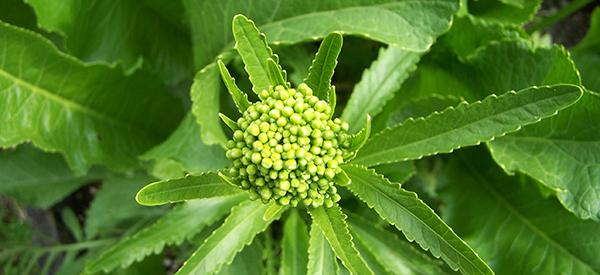
Horseradish
Horseradish (Armoracia rusticana or Cochlearia armoracia) is a perennial in the cabbage family and related to wasabi, kale, turnips, broccoli, and radish. Although the leaves can be cooked as a vegetable, it is the root that is more commonly used to produce condiments of various kinds.
While many of us may be familiar with horseradish sauce or relish out of a store-bought jar, using fresh horseradish can offer both your meals and your health additional benefits.
The History of Horseradish
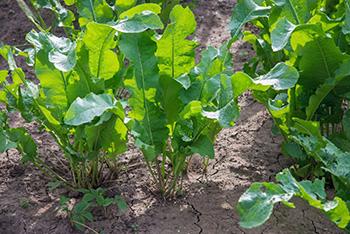 This plant has been cultivated and used for thousands of years in many countries and several continents.
This plant has been cultivated and used for thousands of years in many countries and several continents.
There are records of its use in Ancient Rome, murals depicting horseradish found in Pompeii, herbal remedies from the Medieval period, and mention of it in works by William Shakespeare and in the records of George Washington and Thomas Jefferson.
One of the primary medicinal uses was for the relief of sinus problems.
Where This Plant is Found
Horseradish is thought to be native to western Asia, south-eastern Europe (specifically Hungary), and Russia.
Related: The Complete Map of Edible Plants: Find Out What You Have in Your Area! (Video)
How to Identify Horseradish
The Common Horseradish plant grows in a lettuce-like rosette of leaves. It can reach a height of 2 feet / 61 centimeters and a spread to 18 inches / 45 ½ centimeters. The leaves emerge at ground level rather than from vertical, central stalk, or stem. The second variety that is commonly found is the Bohemian Horseradish. 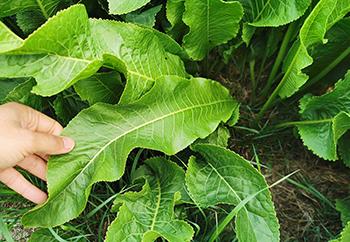
- Leaf: The shiny leaves are bright green, hairless, and unlobed. The edges are wavy and toothed. When crushed, the leaves give off the unmistakable smell of horseradish. They are large, coarse in texture, and a crinkled appearance. Common Horseradish has broad, crinkled leaves. The Bohemian variety has narrower, smoother leaves.

- Flower: The small, white flowers bloom in summer in dense clusters on the ends of tall flower stalks.
There are four petals per bloom that are arranged in opposite pairs, forming a cross.
- Root: The roots are large, fleshy, white, and tapered. Until they are damaged the smell is not noticeable.
 The oils released when the roots are cut are very pungent.
The oils released when the roots are cut are very pungent.
The bitter, hot taste of the root becomes increasingly marked and unpleasant as the oils and root degrade. As a result, these roots must be processed quickly after harvesting.
- Seeds: Once the flowers are blown, they form small oblong seed pods. However, not all plants produce seeds and the chances of buying seeds are small.
When it comes to the medicinal and culinary uses – and the manner of propagation – it is the root that is the most important part of the plant.
Get Your Own Medicinal Seeds, Last 30 Packs Left
How to Grow Horseradish
Horseradish is a perennial that will survive cold winters although the leaves die back. These plants require full sun or light shade and any type of well-drained soil that, ideally, has a pH of 5.5 – 6.5.
You are unlikely to be able to find seeds either online or at a garden center. The way to propagate is from roots, which are sometimes called thongs. Alternatively, you can purchase young plants from suppliers. Once you have a plant, you will be able to propagate from it in spring or fall once it is established.
The way to plant horseradish from a cut root is:
- Pick a suitable location (one that provides enough space and where growth can be controlled as these plants can be invasive)
- Prepare the ground by digging to a depth of approximately 12 inches / 30 ½ centimeters, loosening the soil, and adding some compost
- Plant the root at an angle of 450 and 2 inches / 5 centimeters below the soil line
- If you are planting more than one, do so 30 inches / 76 centimeters apart.
Although Horseradish doesn’t need much attention, there are some care requirements: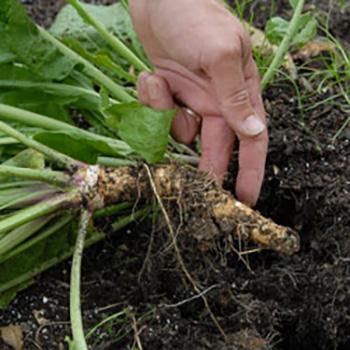
- You must water during dry spells as roots will lose flavor and become woody if they get too dry (1 – 2 inches / 2 ½ – 5 centimeters a week is recommended)
- Too much water will result in soft and bitter roots
- A teaspoon of nitrogen per plant should be watered in or sprinkled over the soil 4 and 8 weeks after planting
- Remove leaves that have turned yellow or brown
- Unlike with some other plants grown for medicine or food, there’s no need to prevent horseradish from flowering
- Keep an eye open for possible pests and leaf diseases.
Some suggest that you remove all but the three or four central shoots. It is thought that if you remove the other suckers the plant will develop fatter, smoother roots.
The primary challenge for many gardeners is not growing but controlling these plants as they spread underground and can colonize large areas relatively fast. As a result, it’s suggested that you dig up all the roots when you harvest and then only plant the ones you want to. Don’t throw unused roots onto your compost pile either or you will have horseradish popping up all over the garden!
How to Harvest And Store This Plant
Harvesting horseradish involves some work and effort. When it comes to storing the fruits of your labor there are several options.
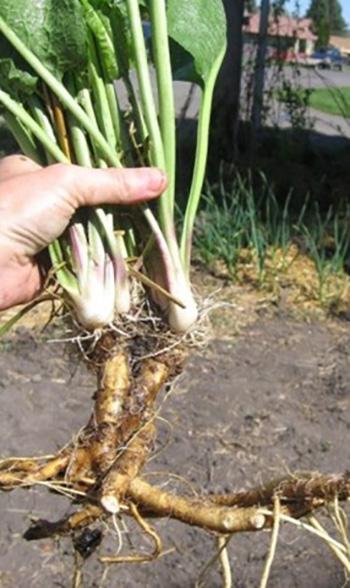
Harvesting
Roots are best when harvested from year-old plants as they become woody and bitter with age. The optimal time – if the weather in your region allows it – is to harvest as soon as the first frosts of the fall kill the leaves. However, if you want extra spice, wait to harvest until spring and just before the plant sends up new shoots.
You need to dig down and around the plant carefully, so you don’t damage the main roots. Remove both the main and the side roots unless you want new plants. If you do, leave the smaller roots to shoot in the next growing season or replant them as described above.
When you select roots to use after harvesting, choose roots that are firm, free of green patches of mold, and not sprouting.
Preparation
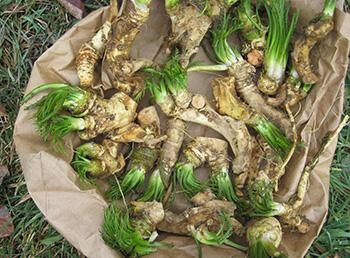 The first rule of horseradish preparation is to be quick! There are two reasons for this. Firstly, the cut roots emit oils, and the bitterness increases over time. Secondly, the fumes released are extremely pungent and can irritate eyes and the linings of the nose. As a result, you should work with it in a well-ventilated area.
The first rule of horseradish preparation is to be quick! There are two reasons for this. Firstly, the cut roots emit oils, and the bitterness increases over time. Secondly, the fumes released are extremely pungent and can irritate eyes and the linings of the nose. As a result, you should work with it in a well-ventilated area.
The initial, basic preparation is not complex:
- Wash the roots well in cold water
- Cut the root into sections that are 3 – 4 inch / 7 ½ – 10 centimeters long
- Peel the root the way you do with root vegetables such as carrots or parsnips.
After that, you can then either chop the root into small pieces and place them into a food processor/blender or grate the sections of peeled root. Adding 2 – 3 teaspoons of vinegar to grated horseradish will reduce the pungency and lengthen the shelf-life.
What Horseradish is Good For And The Natural Remedies Made From it
There are several medicinal uses for Armoracia rusticana, many of which have been used for thousands of years:
- To thin mucus in the sinuses and phlegm in the chest: This makes it easier to dislodge from the sinus cavities or lungs. As a result, remedies made from or incorporating horseradish have been used to relieve colds, sinus pain, and congestion caused by infection or allergies, coughs, and tight chests.
Fresh horseradish can be placed in the mouth, turned into remedies of various forms, or added to boiling water so the steam can be inhaled.
- As a diuretic: This root material stimulates urine flow which may help to ease urinary tract problems such as bladder infections and even help to treat kidney stones.
- As a digestive aid: Horseradish boosts the digestive system and is believed to improve the overall process. However, this root in its raw form should not be eaten on an empty stomach as it can cause severe nausea.
While this plant may not have as many health and well-being applications as some others, there can be no arguing with some 3,000 years of anecdotal evidence of its effectiveness against common, unpleasant conditions such as hay fever.
What Parts of The Plant Are Used in Remedies?
The only part of the horseradish plant that is used in remedies or medicinal preparations is the roots.
A DIY Horseradish Recipe
So-called dry sinus infections and problems are very unpleasant. The sinus cavities can’t drain, and they become increasingly blocked with thick mucus. This, in turn, causes inflammation and pressure. This simple horseradish remedy can break down the mucus and end this cycle of pain and reduce the chances of infection.
Ingredients
- 4 ounces / 8 tablespoons of fresh horseradish root
- ½ cup of raw (preferably organic) honey
- ¼ cup apple cider vinegar
- ¼ teaspoon sea salt
Method
- Peel the roots

- Roughly chop the root into large pieces

- Place the chunks into a food processor and pulse until it is finely chopped

- Place the chopped horseradish into a mixing bowl and add the vinegar, honey, and salt and mix well. Don’t delay too long before adding the vinegar or the horseradish will get hotter and hotter… unless you enjoy the bite!

- Place the mixture into a labeled glass jar that has a tightly fitting lid.
If you don’t have a food processor or blender you can grate the root. Be aware, though, that this method takes longer which means (a) the root is exposed to air for a more extended period and (b) the horseradish will therefore be much spicier / hotter.
How to Use And Store
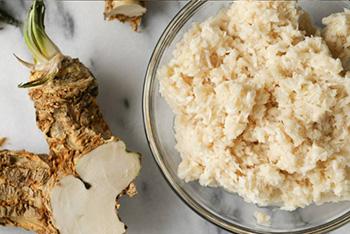 To treat badly blocked sinuses, take 1 – 2 teaspoons a day. However, don’t ever take it on an empty stomach as it can lead to nausea!
To treat badly blocked sinuses, take 1 – 2 teaspoons a day. However, don’t ever take it on an empty stomach as it can lead to nausea!
Keep in mind that this mixture packs a punch, so start with a small amount and see how you do. You could put a small quantity into your mouth, chew, and swallow. Alternatively, if you enjoy the flavor and heat you could use it as a condiment. For instance, it goes well with cheese on bread or a cracker.
Store the jar in the fridge where it will keep for up to a year thanks to the preservative qualities of both honey and vinegar.
How to Store Horseradish Root
There are a few options when it comes to storage:
- You can store unwashed roots in the vegetable bin or crisper drawer of your refrigerator. You can use a plastic bag, plastic wrap, or a damp towel but remember to freshen the towel every few days so that it doesn’t dry out. If correctly stored, horseradish will stay fresh this way for up to three months.
- You could also place the roots in damp sawdust or soil in a dark, cool cellar or basement where they will stay fresh and usable for up to 10 months.
- Freezing is not an option with whole roots although grated horseradish can be frozen and kept for up to 6 months. The drawback is that it will lose pungency and some potency over time.
- Grated horseradish can be kept in an airtight container in your fridge for 7 to 10 days. Adding some vinegar may extend this up to 3 weeks.
1 Cup Before Bed Shrinks Belly Fat All Night (Video)
Regardless of how you store it, if the roots become dried and wrinkled or soft, moldy, or turn green you must throw them away. Similarly, grated horseradish that turns black must be disposed of.
What Plants Resemble Horseradish?
A group of plants that are sometimes confused with horseradish are docks. However, there are differences too that can help to differentiate them:
Horseradish
| Feature | Common HorseradishArmoracia rusticana | Curled DockRumex crispus |
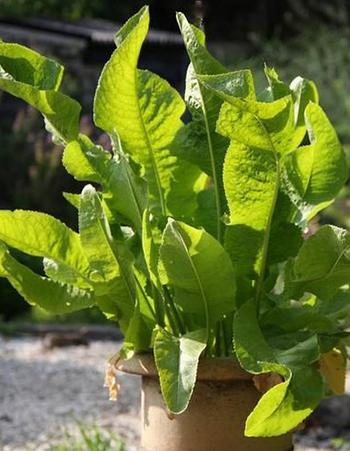 |
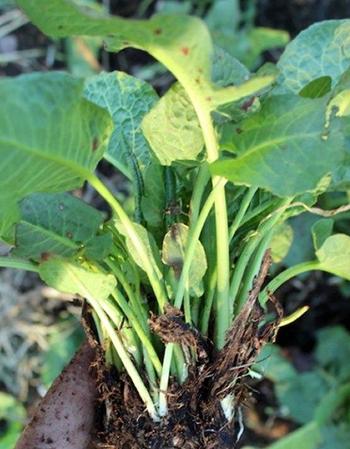 | |
| Size | 2 feet / 61 centimeters and a spread to 18 inches / 45 ½ centimeters; base rosette | 2 feet / 61 centimeters and a spread to 12 inches / 30 ½ centimeters; base rosette |
| Leaves | Shiny leaves with a wavy and toothed edge | Matt leaves with wavy or curled edges |
| Flowers | Clusters of small, cross-shaped / 4 petalled white flowers | Clusters of flowers along a stem, reddish or yellowish-green |
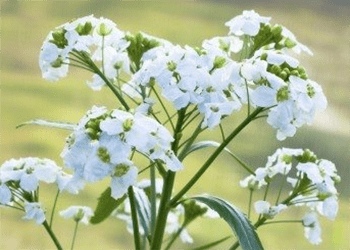 |
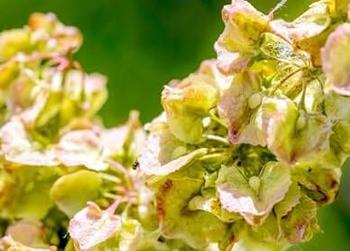 | |
| Root | Large, fleshy, and tapered; sends out roots that later shoot | Large, fleshy, thick, and tapered taproot |
| Odor | Distinctive horseradish smell from crushed leaves and cut roots | No horseradish-like aroma |
| Natural propagation | Via roots | Via wind dispersal of seed |
As can be seen from this table, it is unlikely that horseradish and dock would be confused when the plants are in flower. The similarities lie more in the leaves, plant shape, and growth pattern.
Warning And Cautions
The reason for the pungent fumes and hot taste of horseradish is the volatile oils the roots release when they are damaged (which includes during cutting, peeling, and copping). While these oils provide the familiar taste and are beneficial in small amounts, too much can cause gastric distress such as nausea, vomiting, and diarrhea.
Certain individuals should avoid horseradish entirely:
- Anyone who is allergic to other cruciferous vegetables such as cabbage
- Pregnant and breastfeeding women.
Others should only consume small or moderate amounts:
- Patients with liver conditions such as hepatitis
- Individuals with thyroid disorders or imbalances
- People who suffer from, or are prone to, acid reflux, indigestion, and inflammatory bowel diseases.
If you are unsure about using a horseradish-based remedy, speak to your healthcare practitioner before you start.
You may also like:
How To Make Fire Cider The Ultimate Natural Remedy To “Burn” Your Cold Away
Similar to Morphine: The Best Natural Painkiller that Grows in Your Backyard (Video)
What Happens If You Eat Cabbage Every Day?








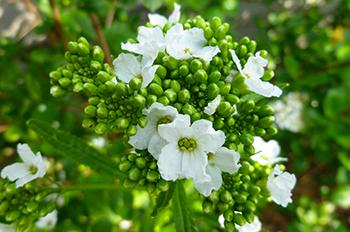
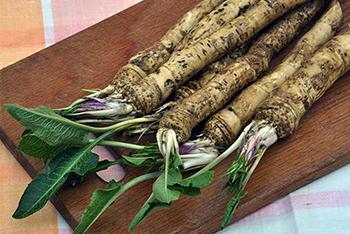 The oils released when the roots are cut are very pungent.
The oils released when the roots are cut are very pungent.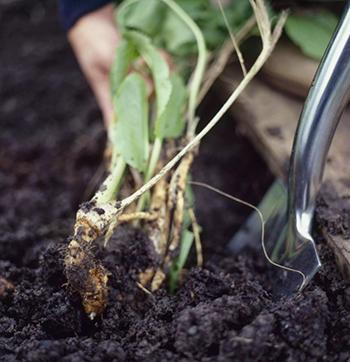
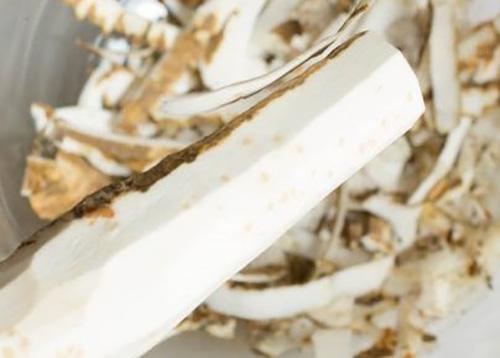
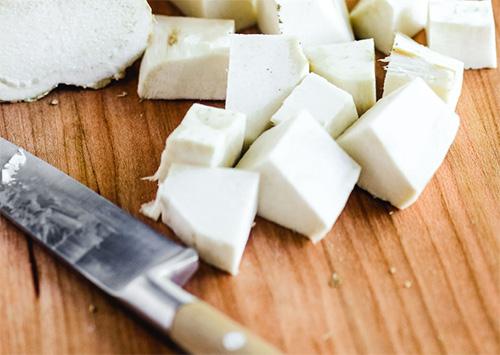
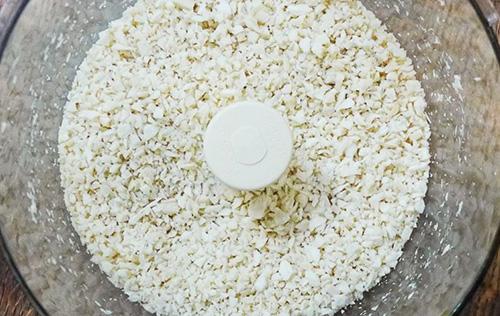
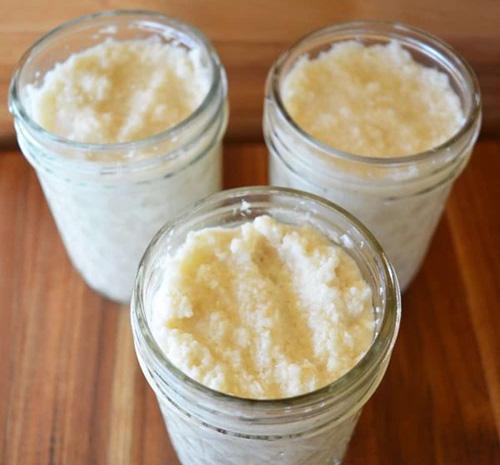
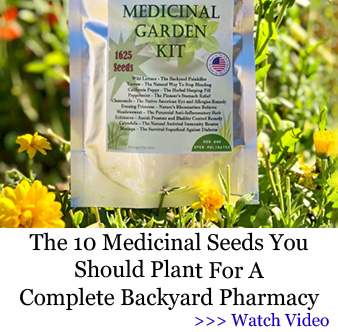
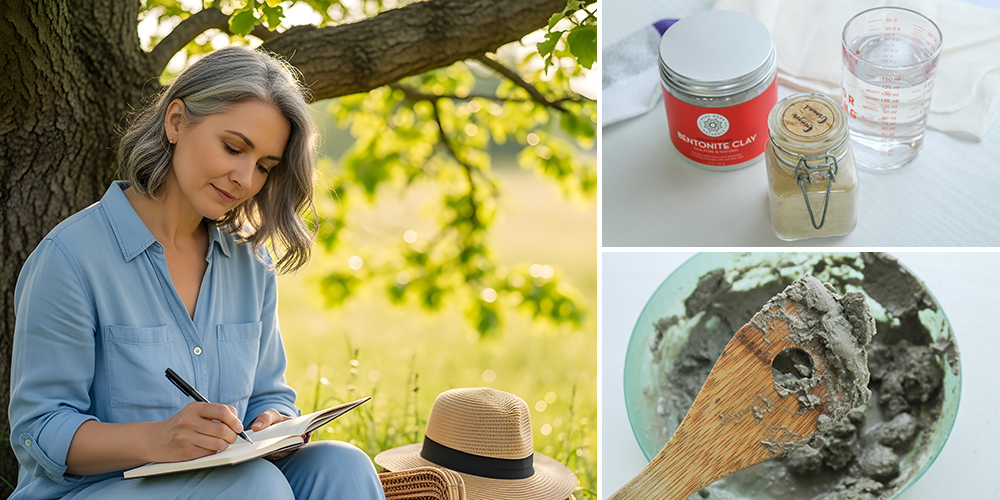
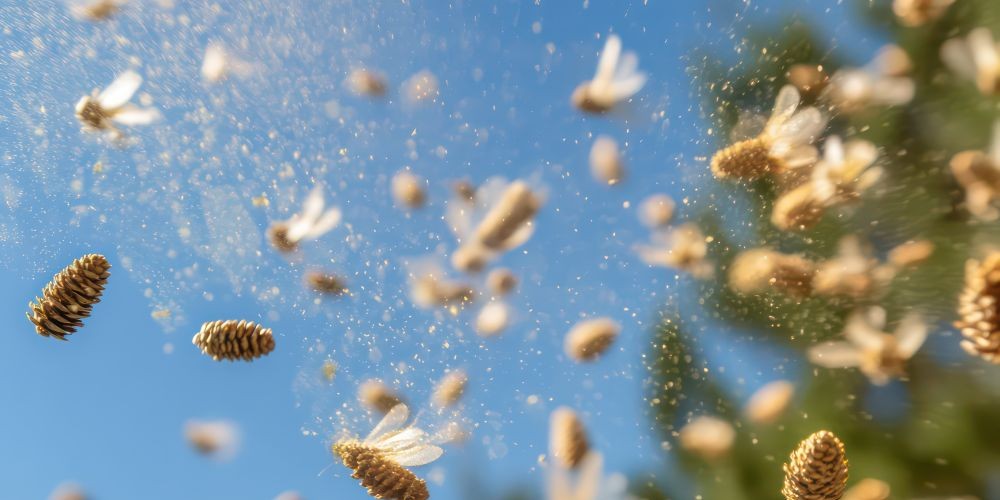
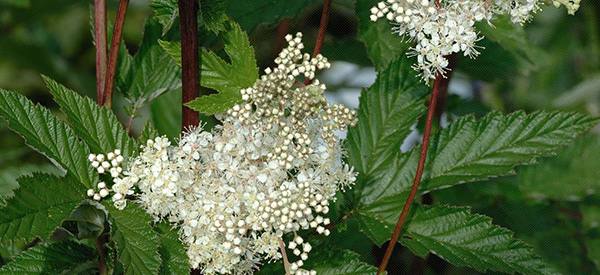
Wondering if the commercial product works as well as the homemade products
I would like to know the answer to the same question you asked. As it is easier to buy a jar at a grocery store than to grow and can horseradish.
Hi,
Indeed it is easier to buy a jar from the store, but using fresh horseradish can offer both your meals and your health additional benefits.
God bless!
Nothing can beet fresh horseradish ! So good with grill meat !! It is easy to grow and you can wrap the leaves around your neck, cover with worm towel and it helps with sore throat.
Is this only for blocked Sinus? If your nose constantly runs, and it feels like a sinus issue, (or allergys) would this work? I have this year round, so ???? Appreciate the help.